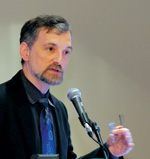ACP's president converting to a medical home for quality care
Pilot studies of the patient-centered medical home show success and satisfaction for the doctors willing to make the change. ACP's president begins his own conversion, and shares the results with the entire membership.
In health care as elsewhere, I believe in free enterprise that aligns incentives for appropriate behavior. Patients need access to quality affordable medical care. Physicians and other members of the health care team need to be valued and reimbursed appropriately to ensure an ongoing workforce. But even in the wake of health care reform, we face issues that challenge these principles.
For example, we as doctors are expected to report on quality measures to more and more payers, lest they pull data from always late, and sometimes erroneous, claims. Reporting takes time and resources that most small practices don't have. And it seems almost every day that there is some new regulation with which we must comply. I am not saying that these added demands are not good for patients, but they are unfunded mandates that also require time and resources.
Further, we see limited revenue and increasing expenses, which is hard for those already in practice and crystal clear to practitioners considering specialty options. Consequently, and perhaps most important for the future of our profession, few medical students are choosing careers as generalists and in certain subspecialties. Who will replace us when we retire?
As bad as the current situation is for many internists, it could get worse. If we were horse-drawn carriages moving into the automotive era, it would be sad to see us go, but not crucial for our society. What we do, however, is more important than ever. It is crucial for patients to be able to get the quality care that we and our successors can provide. For their sake, we cannot afford to become medical dinosaurs.
This column is not intended to be yet another doctors' lounge conversation about how things have gone to the dogs, but a discussion of a new approach that offers an opportunity to effectively deal with many of these issues. In the years that it will take to build up the right workforce, we need a new model of care that will optimize benefit to patients and allow all members of the primary care medical team to maximize their efforts and their satisfaction with the work they do.
Organizational models and groups of all sizes can adopt the approach of the patient-centered medical home. Don't let the words scare you or make your eyes glaze over. This natural skepticism about what are perceived as unproven remedies comes from our training and is the very nature of internists. Many of the challenges internists face daily are addressed in and by the patient-centered medical home.
I like the results that are coming in from pilot projects, such as those described in the Patient-Centered Primary Care Collaborative's publication Proof in Practice, starting on page 81. From Group Health Cooperative of Puget Sound we see the following initial results using a patient-centered medical home model:
- better quality,
- reduction in ER and inpatient hospital costs,
- better value proposition and
- better work environment.
Results from these pilot studies of large and small groups are pointing in the same direction. There has been less staff burnout, and practices have seen a major improvement in recruitment and retention of primary care physicians. Patients appear to be happier because they have access to a physician-led team with proper resources and an increased ability to provide the right care at the right time. Those paying the bills are happy with initial trends toward the illusory bending of the cost curve, albeit in defined populations over relatively short periods of time. We are even hearing encouraging comments from physicians who decided against retirement because they are more able to practice medicine as they used to, often with only a slightly smaller patient panel but the understanding that the resources are there to provide proper care.
As I write this column, my medical group of eight physicians and a nurse practitioner in Fayetteville, Tenn., is working with Blue Cross of Tennessee to begin this process. From this model we seek the time, staff and financial resources to make medical practice flow, rather than being forced to comply with yet another decree and resent our work life even more. We have a wonderful tool from ACP, the Medical Home Builder, that for a nominal price identifies the areas we need to improve in our practice and provides links to resources that allow us to do so. We are finding that many of these “opportunities for improvement” are the very things we are “dinged” for in practice audits. We do quite well for a small practice in those audits, but the opportunities for improvement are welcome, as long as we have the means to address them. I am excited about a process that allows us to deal with quality monitoring on the front end rather than after the fact.
The key to establishing and running a medical home is having the proper tools and talent to oversee longitudinal care of patients rather than having to focus merely on the reason for any given visit on a certain day. It's the kind of care I want for myself and my family. I am very excited to begin this process in my own medical practice, and I'm also excited to watch its evolution nationally as the medical home model is more widely adopted and tested.



